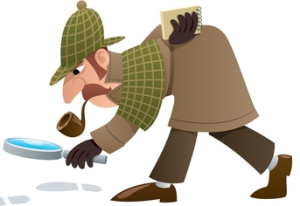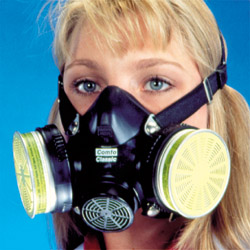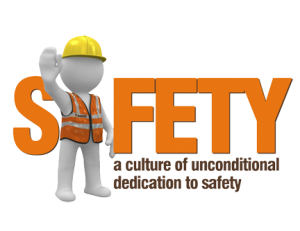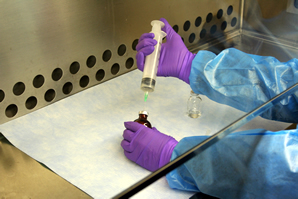 Thousands of accidents occur throughout the United States every day. The failure of people, equipment, supplies, or surroundings to behave or react as expected causes most of them. Accident investigations determine how and why these failures occur. By using the information gained through an investigation, a similar, or perhaps more disastrous, accident may be prevented. It is important to conduct accident investigations with prevention in mind.
Thousands of accidents occur throughout the United States every day. The failure of people, equipment, supplies, or surroundings to behave or react as expected causes most of them. Accident investigations determine how and why these failures occur. By using the information gained through an investigation, a similar, or perhaps more disastrous, accident may be prevented. It is important to conduct accident investigations with prevention in mind.
Tag: safety at work
Respirators
 Respirators protect the user in two basic ways. The first is by the removal of contaminants from the air. Respirators of this type include particulate respirators, which filter out airborne particles; and “gas masks” which filter out chemicals and gases. Other respirators protect by supplying clean respirable air from another source. Respirators that fall into this category include airline respirators, which use compressed air from a remote source; and self-contained breathing apparatus (SCBA), which include their own air supply.
Respirators protect the user in two basic ways. The first is by the removal of contaminants from the air. Respirators of this type include particulate respirators, which filter out airborne particles; and “gas masks” which filter out chemicals and gases. Other respirators protect by supplying clean respirable air from another source. Respirators that fall into this category include airline respirators, which use compressed air from a remote source; and self-contained breathing apparatus (SCBA), which include their own air supply.
via CDC – Respirators – NIOSH Workplace Safety and Health Topic.
Portable Ladder Safety
 Falls from portable ladders (step, straight, combination and extension) are one of the leading causes of occupational fatalities and injuries.
Falls from portable ladders (step, straight, combination and extension) are one of the leading causes of occupational fatalities and injuries.
- Read and follow all labels/markings on the ladder.
- Avoid electrical hazards! – Look for overhead power lines before handling a ladder. Avoid using a metal ladder near power lines or exposed energized electrical equipment.
- Always inspect the ladder prior to using it. If the ladder is damaged, it must be removed from service and tagged until repaired or discarded.
- Always maintain a 3-point (two hands and a foot, or two feet and a hand) contact on the ladder when climbing. Keep your body near the middle of the step and always face the ladder while climbing (see diagram).
- Only use ladders and appropriate accessories (ladder levelers, jacks or hooks) for their designed purposes.
- Ladders must be free of any slippery material on the rungs, steps or feet.
- Do not use a self-supporting ladder (e.g., step ladder) as a single ladder or in a partially closed position.
- Do not use the top step/rung of a ladder as a step/rung unless it was designed for that purpose.
- Use a ladder only on a stable and level surface, unless it has been secured (top or bottom) to prevent displacement.
- Do not place a ladder on boxes, barrels or other unstable bases to obtain additional height.
- Do not move or shift a ladder while a person or equipment is on the ladder.
- An extension or straight ladder used to access an elevated surface must extend at least 3 feet above the point of support (see diagram). Do not stand on the three top rungs of a straight, single or extension ladder.
- The proper angle for setting up a ladder is to place its base a quarter of the working length of the ladder from the wall or other vertical surface (see diagram).
- A ladder placed in any location where it can be displaced by other work activities must be secured to prevent displacement or a barricade must be erected to keep traffic away from the ladder.
- Be sure that all locks on an extension ladder are properly engaged.
- Do not exceed the maximum load rating of a ladder. Be aware of the ladder’s load rating and of the weight it is supporting, including the weight of any tools or equipment.
Safety – What is a Near Miss?
 A Near Miss is an unplanned event that did not result in injury, illness, or damage – but had the potential to do so. Only a fortunate break in the chain of events prevented an injury, fatality or damage; in other words, a miss that was nonetheless very near.
A Near Miss is an unplanned event that did not result in injury, illness, or damage – but had the potential to do so. Only a fortunate break in the chain of events prevented an injury, fatality or damage; in other words, a miss that was nonetheless very near.
A faulty process or management system invariably is the root cause for the increased risk that leads to the near miss and should be the focus of improvement. Other familiar terms for these events are a “close call,” a “narrow escape,” or in the case of moving objects, “near collision” or a “near hit.”
Bloodborne Pathogens and Needlestick Prevention
 What are bloodborne pathogens?
What are bloodborne pathogens?
Bloodborne pathogens are infectious microorganisms in human blood that can cause disease in humans. These pathogens include, but are not limited to, hepatitis B (HBV), hepatitis C (HCV) and human immunodeficiency virus (HIV). Needlesticks and other sharps-related injuries may expose workers to bloodborne pathogens. Workers in many occupations, including first aid team members, housekeeping personnel in some industries, nurses and other healthcare personnel may be at risk of exposure to bloodborne pathogens.
What can be done to control exposure to bloodborne pathogens?
In order to reduce or eliminate the hazards of occupational exposure to bloodborne pathogens, an employer must implement an exposure control plan for the worksite with details on employee protection measures. The plan must also describe how an employer will use a combination of engineering and work practice controls, ensure the use of personal protective clothing and equipment, provide training , medical surveillance, hepatitis B vaccinations, and signs and labels, among other provisions. Engineering controls are the primary means of eliminating or minimizing employee exposure and include the use of safer medical devices, such as needleless devices, shielded needle devices, and plastic capillary tubes.
via Safety and Health Topics | Bloodborne Pathogens and Needlestick Prevention.
The 10 most dangerous jobs in America
 According to a September report from the Bureau of Labor Statistics BLS, fisherman, loggers and pilots were the three deadliest in the United States in 2011. The organization recently examined the occupations with the highest rate of work-related deaths and found that of all U.S. workers, fishermen are the most likely to die on the job.
According to a September report from the Bureau of Labor Statistics BLS, fisherman, loggers and pilots were the three deadliest in the United States in 2011. The organization recently examined the occupations with the highest rate of work-related deaths and found that of all U.S. workers, fishermen are the most likely to die on the job.
Here is the full list of work-related deaths in 2011 per 100,000 workers:
- Fisherman 121.2
- Loggers 102.4
- Pilots 57.0
- Farmers and Ranchers 25.3
- Police Officers 18.6
- Construction Workers 15.7
- National Average 3.5
- Firefighters 2.5
- Cashiers 1.6
- Office Admin 0.6
- Business and Finance Staff 0.5
Safety and Health Program Assessment
 There are three basic methods for assessing safety and health program effectiveness:
There are three basic methods for assessing safety and health program effectiveness:
- Checking documentation of activity.
- Interviewing employees at all levels for knowledge, awareness, and perceptions.
- Reviewing site conditions and, where hazards are found, finding the weaknesses in management systems that allowed the hazards to occur or to be “uncontrolled.”
Some elements of the safety and health program are best assessed using one of these methods. Others lend themselves to assessment by two or all three methods.
Hazardous Drug Exposures in Health Care
 Health care workers who prepare or administer hazardous drugs (e.g., those used for cancer therapy, and some antiviral drugs, hormone agents, and bioengineered drugs) or who work in areas where these drugs are used may be exposed to these agents in the workplace. About 8 million U.S. healthcare workers are potentially exposed to hazardous drugs, including pharmacy and nursing personnel, physicians, operating room personnel, environmental services workers, workers in research laboratories, veterinary care workers, and shipping and receiving personnel.
Health care workers who prepare or administer hazardous drugs (e.g., those used for cancer therapy, and some antiviral drugs, hormone agents, and bioengineered drugs) or who work in areas where these drugs are used may be exposed to these agents in the workplace. About 8 million U.S. healthcare workers are potentially exposed to hazardous drugs, including pharmacy and nursing personnel, physicians, operating room personnel, environmental services workers, workers in research laboratories, veterinary care workers, and shipping and receiving personnel.
via CDC – Hazardous Drug Exposures in Health Care – NIOSH Workplace Safety and Health Topic.
Heat Stress Risk
 Workers who are exposed to extreme heat or work in hot environments may be at risk of heat stress. Exposure to extreme heat can result in occupational illnesses and injuries. Heat stress can result in heat stroke, heat exhaustion, heat cramps, or heat rashes. Heat can also increase the risk of injuries in workers as it may result in sweaty palms, fogged-up safety glasses, and dizziness. Burns may also occur as a result of accidental contact with hot surfaces or steam.
Workers who are exposed to extreme heat or work in hot environments may be at risk of heat stress. Exposure to extreme heat can result in occupational illnesses and injuries. Heat stress can result in heat stroke, heat exhaustion, heat cramps, or heat rashes. Heat can also increase the risk of injuries in workers as it may result in sweaty palms, fogged-up safety glasses, and dizziness. Burns may also occur as a result of accidental contact with hot surfaces or steam.
Workers at risk of heat stress include outdoor workers and workers in hot environments such as firefighters, bakery workers, farmers, construction workers, miners, boiler room workers, factory workers, and others. Workers at greater risk of heat stress include those who are 65 years of age or older, are overweight, have heart disease or high blood pressure, or take medications that may be affected by extreme heat.
Prevention of heat stress in workers is important. Employers should provide training to workers so they understand what heat stress is, how it affects their health and safety, and how it can be prevented.
via CDC – Heat Stress – NIOSH Workplace Safety and Health Topic.
Stay Safe at Work
 If work isn’t performed safely, it can put a lot of wear and tear on your body. Back injuries are the most common type of workplace injury.
If work isn’t performed safely, it can put a lot of wear and tear on your body. Back injuries are the most common type of workplace injury.
Make simple changes to prevent injuries and stay healthy:
- Lift things safely.
- Arrange your equipment to fit your body.
- Take short breaks and stretch your muscles.
- Eat a healthy diet and stay active.
- Watch your weight.
- Get enough sleep.
via Workplace Safety.
